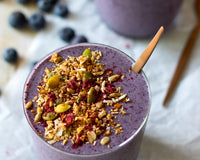The biggest myths of the fitness world

This world is not short of fitness myths. You can almost call them conspiracies. Some will spread false information, like targeting emotional relationship with food to build their well-thought sales’ pitch and make people buy their so-called specialized training program or poor-quality shakes.
1. Target fat loss
This is the most common media weapon. They hit you where it hurts the most and they know how to convince you. It’s so easy when most people want a quick fix and are willing to invest in the magic pill faster than they sneeze.
You can’t lose fat at specific locations on your body, but the opposite happens when you gain fat. Most people will gain fat around their hips and stomach, which is often the result of stress or hormonal issues.
The problem is that fat loss and/or gaining muscle is systemic. It is the result of a well-thought plan and good nutrition habits that will make your body burn fat and gain lean muscle tissue. You must maximize rest, train efficiently, not maximally, and follow the plan for a long while, then never look back.
2. Fasted training
For this one, I go with how people feel. Obviously, if you have planned a workout that might leave you dead, I would strongly advise you to eat something prior to it. Some people just can’t eat before a session. If you train first thing in the morning, then it could be done before getting your first meal. Depending on the activity, the amount of waiting time you need could dictate if you have enough time to eat prior to your training. For example, my athletes can’t eat an hour or two before BJJ or else they will throw up. The plan goes according to each individual but usually, try to prepare a meal that is easily digested and eat it 2 to 3 hours before the effort. You could also use enzymes to improve the speed of digestion if need be. Individualization is the key.
There is a great debate about the best method to lose fat, workout on an empty stomach in the morning or after a good breakfast? Here is one for fans of fasted cardio.
Two groups of young men were tested by measuring their oxygen consumption rate (VO2) and respiratory quotient (RQ) post-workout (cardio training at 65% MHR) with breakfast and fasting. Each group had the same quantity and quality of food for the next 24 hours. The breakfast group had the largest increase in VO2 and QR, indicating greater fat oxidation and there was a significant difference between the two groups in the 24 hours following exercise. The author concluded that to train on an empty stomach does not increase fat oxidation, but a light meal before training will maximize your results.
Motivation influences much of our day. We are frequently asked how to improve people’s motivation, whether for training, cheating (food-wise), etc. Believe it or not, your breakfast has a lot to do with it when it is time to kick ass. Researchers from The University of Missouri have examined the benefits of a high protein breakfast on obese young girls or overweight late teenagers. They studied the hormonal and neural effects of a high protein breakfast on appetite during the day, satiety, motivation and the need to reward themselves with food. The first group had lunch with 350 kcal, cereal (13 grams of protein) and a second group with the same number of Kcal but consisting of eggs and beef. After only six days, they concluded that only the group with high protein breakfast had a significant (positive) difference in satiety and greater motivation.
3. No pain no gain
There are three types of pain, one that goes away after a few sets, one that gets worse or is always there as you keep going and the one that you can’t move the limb or joints.
Although it seems pretty obvious when you shouldn’t train, the first one is where people don’t understand. It’s ok to be sore, and in fact, you should work out even if you are, unless you have a hard time moving, but when it gets to that point, you have to look past your workout. Being sore after each workout is not normal. It is often the result of bad nutrition and dehydration. Make sure you drink enough water and eat enough proteins to support those hard workouts. Consider taking a post-workout shake to support recuperation with one of the best proteins around, our very own New Zealand whey. This blend from New Zealand brings quality and taste to a unique whey protein. Its high biological value allows for complete absorption and encourages muscular and immune system recovery. Free of hormones, antibiotics, pesticides, gluten, GMOs and artificial colors, NzW is your best choice in whey proteins. The filtration process used during its manufacture allows it to maintain the integrity of the active ingredients to create a top of the line blend.
4. Full squats = bad for your knees
Would you ONLY do half reps on the biceps curl? Or on the bench-press? Sounds ridiculous, doesn’t it? Well, you can relate your elbow joint as you do with your leg. The knee is made to bend fully and only when you start limiting that range, you might start to see real injuries happen. The need to load each part of the strength curve of a squat or a split squat is a no brainer. If you can’t go fully down, you might need to consult someone who can find the structural issues to help you improve your range of motion.
Your knee is biomechanically made to bend more than 90 degrees. In fact, you should be able to squat down until your hamstring touches your calf. You can’t? Well, it’s probably a flexibility problem, coming from the ankles, the quads, the hips or lower back. See the lack of flexibility as a way to protect the joints. Your lack of flexibility did not cause a problem. A problem (nutritional or structural) or an injury caused your lack of flexibility.
5. Targeting specific parts of a muscle
When a muscle contracts, it never fully does, or else it would rip at some point. You can never contract a muscle at 100%. What you can do though is target specific areas at a HIGHER degree. For example, if you want to target the upper clavicular pec, you would use an incline bench. However, the lower pec will contract at a lower rate of the effort. The same goes for every muscle of the body. There will never be a perfect exercise that can target all the muscle fibers at once, the perfect strength curve and angle, unfortunately, doesn’t exist.
6. Bigger weights = bulkier muscles
One of the main myths that most women tend to believe. Maybe because they fear about working harder? Don’t shoot the messenger. If that was true, we would see some muscle freaks walking around.
Let’s be real. Some start training, they lift heavier and like the feeling, but fail to control the diet and nutrition aspects of a new plan. So, the weights are not making you bulkier, cupcakes do.
7. Stretching for injury prevention.
I use stretching only if necessary. However, why is a muscle tight in the first place?
Instead of trying to stretch a muscle that is already too tight, try to figure out why it is pulling so much. Why it is tight in the first place? I don’t see it much as a tight muscle, I see it more like an overworking muscle, as some type of compensation. This is where a good strength coach or osteopath could guide you on the right path.
If you just started training, let your nutrition do its job. Let the nutrients sink in and feed those joints, ligaments, and tendons. Let the strength training do what it is supposed to do. Put stress on a muscle so it learns to relax after.
Only if you have been training for a while and you still see some strength discrepancies and unilateral range of motion issues would you try to stretch a tight muscle?
You might also want to look at the chain of muscle that seems to be lacking flexibility. One tight muscle always has some kind of structural issues, something that makes it unable to relax and work to its full capabilities. Skilled strength coaches and trainers will find the issues.
8. Running on a treadmill is the same as running outside
First and foremost, when you set the speed on the treadmill, you have to follow the pace. So the treadmill belt is pushing your legs back. Going outside, you are pushing yourself forward which makes it a lot harder than trying to follow a pace on a treadmill. To adjust the difficulty and make the treadmill more realistic, increase the incline to about 3 degrees.
9. Sweating the sickness out
The problem with training sick is that it only helps if your body has had the time to increase its own immunity to the given illness. You got sick because your immune system was weaker. Going for a workout while being sick won’t make your immune system stronger, especially if you train hard. The best remedy is a hypertrophy workout. Plenty of rest, while keeping it quick and efficient. Pushing your heart rate to the max will only make it harder to rest and regenerate.
10. You burn more fat when you sweat.
So, with that logic, training in a sauna would make you burn more fat? Or training in the summer makes you burn more fat? The truth is sweat is a biological reaction of the body to overheating, allowing the skin to cool down and internal body temperature to adjust. It has nothing to do with fat, but only an aqueous solution of salt and organic substances released by sweat glands. Go back to point #1 and you’ll get the idea.
Coach Eric





